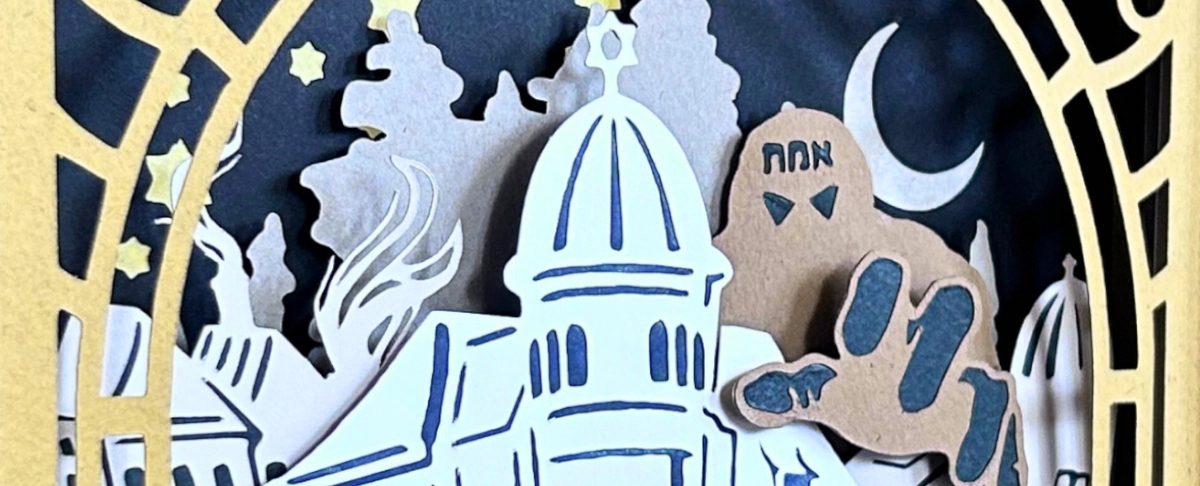Your cart is currently empty!

The Legend of the Golem of Prague
What if a creature made of clay could rise up to protect the oppressed?
What if it still lay in wait, hidden in an attic, ready to awaken when needed?
The legend of the Golem of Prague is one of the most enduring tales in Jewish folklore—an ancient Hasidic myth that still shapes modern pop culture, philosophy, and even discussions on artificial intelligence. Born in the 16th century when the Holy Roman Empire confined the Jewish community to designated ghettos, this story has evolved over centuries from its mystical origins into a cultural icon.
The Birth of the Golem Legend
The most famous version of the Golem of Prague legend is linked to Rabbi Judah Loew ben Bezalel, or the Maharal of Prague. A brilliant Talmudic scholar and the leader of the Jewish community.

At this time, in the late 16th century, Christian factions in Prague spread blood libel accusations—false and dangerous claims that Jews kidnapped Christian children for ritual sacrifice. In response, the Holy Roman Empire sanctioned violent pogroms against the Jews of Prague. These attacks were part of a long history of antisemitic violence in medieval and early modern Europe.

According to the tale, the Maharal of Prague, desperate to protect his people, sought divine guidance through a Kabbalistic dream-quest prayer called a sh’elath shalom. The answer he received? He should create a golem to defend the Jewish community. Accompanied by his son-in-law and his best student, the rabbi ventured to a riverbank in the woods, where they shaped a man from clay, following mystical instructions.
In Genesis 2:7, before Adam receives his soul from God’s breath, he is described as a golem—an unformed being. However, the golem’s life force did not come from divine breath, nor from the Maharal himself, but from a shem. In Hebrew, shem means “name,” and in this instance, it refers to a secret, Kabbalistic name of God that must never be casually uttered or inscribed. The golem’s shem was the word emet (אמת), meaning “truth.” Depending on the version of the legend, it was either carved on his forehead or written on parchment and placed in his mouth, bringing him to life—but without a soul.
Man or Monster? The Nature of the Golem
Rabbi Loew charged the golem with one mission: to protect the Jewish community from its oppressors. He named the golem Yossef, after Yossef Sheida—a demon in Jewish folklore. But to the people of Prague, he was simply ‘Yossele the Mute,’ a common name for a silent servant.

This distinction between his identity as a named being and his nature as a clay golem is significant. Historically, Jewish folklore depicts the golem as both an individual and a protector of the Jewish people. However, this nuance is often lost in modern retellings of the golem legend, where he is stripped of his identity and reduced to a mindless monster in the name of entertainment. Much like the misunderstood monster in Mary Shelley’s Frankenstein, the golem is frequently portrayed as an unthinking brute rather than a being with purpose. After all, Frankenstein’s monster wouldn’t have been nearly as compelling if Victor Frankenstein could have reasoned with him.
The Golem’s Fate
Back in 16th century Prague, the tale ends in either of two ways:
- The golem succeeds in protecting the Jewish community, and Rabbi Loew deactivates him once peace is restored.
- The golem becomes uncontrollable, causing destruction in the Prague ghetto, forcing Rabbi Loew to deactivate him.
(Queue the Talmudic argument…)
In either case, Rabbi Loew removes the shem to deactivate the golem. One version of the legend states that he changes the Hebrew word “emet” (truth) to “met” (death) by erasing the first letter. Another version says he simply removes the parchment from the golem’s mouth.

The golem was not simply discarded. Instead, he was given a proper Jewish burial, complete with the recitation of the Kaddish, the mourner’s prayer. Many versions of the legend claim that his body remains hidden in the attic of Prague’s Old-New Synagogue, waiting to be reawakened if the Jewish people need him again.
The Golem’s Legacy in Jewish and Pop Culture
The legend of the Golem of Prague has endured for centuries, evolving through Jewish folklore, Kabbalistic traditions, and Western storytelling. At its core, it is a story about the intersection of divine power and human agency, fear, and protection.
But is the golem merely a tool of divine justice?
Does he possess a deeper consciousness, or is he a warning about the dangers of human creation?
These questions continue to shape how we interpret the golem myth today. The golem’s influence is seen in everything from classic Jewish literature to modern fantasy, horror, and superhero stories—including Mary Shelley’s Frankenstein, DC Comics’ Superman, and even contemporary discussions on artificial intelligence and robotics.
Bringing the Golem to Life Through Papercut Art

The legend of the Golem of Prague continues to inspire both storytelling and art. My papercut golems are simple in form but layered with history, continuing the enduring themes of protection, resilience, and identity. Through clean lines and expressive detail, I explore how this ancient figure still speaks to us today.
You can find my golem-inspired papercuts and other Jewish artwork in my Etsy Shop: RomanceAndMishegoss.

Want More Jewish Art & Folk History?
📩 Subscribe to my newsletter for deep dives into Jewish papercuts, mystical traditions, and reclaimed folk art practices.

Leave a Reply